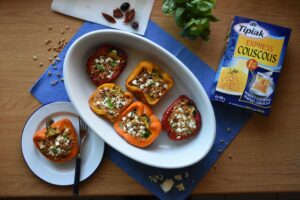Description & Varieties
Couscous is a tiny pasta made of wheat or barley. The different types of couscous are produced from coarsely-ground durum wheat semolina which is moistened and tossed with fine wheat flour until it forms small granules or spheres. It’s commonly served in North African, Moroccan, Tunisian, and Algerian cuisine.
There are 3 main types of couscous which vary in texture.
- Moroccan couscous is the smallest – a bit larger than semolina – and the most common. The instant type cooks up fast because it’s been precooked by steaming and then dried. It just needs to be rehydrated in hot water for a few minutes. Tipiak express couscous is conveniently packed in boil-in-bag sachets containing the amount for 2 servings and is ready in less than 2 minutes.
- Israeli couscous, also called pearl couscous, is larger and resembles tiny pieces of pasta. The increased size compared to Moroccan couscous requires a little longer, about 10 minutes, to cook. It’s simmered on the hob and then briefly covered until tender. It has more of a pasta-like taste and texture with some springiness.
- Lebanese couscous is also commonly known as kusksu, the name of the finished traditional Maltese dish. It is larger than Israeli couscous and takes the longest to cook. It’s the largest in size, similar to a pea.
Benefits of all the types of couscous
- Couscous is a convenient product to have stocked in the pantry as an easy and fast alternative to rice and pasta.
- Couscous adds a carbohydrate element to the dish, is low in fat and contains some protein, vitamins and minerals.
Cooking with couscous
- The variety will determine how to cook couscous. When cooked, couscous looks like golden spheres that have a pleasant nutty flavour.
- The neutral taste allows it to be kept as a simple side dish to serve with soups, stews and braises.
- It can also be transformed into more interesting recipes like fresh salads or infused with stocks, meats, vegetables, and spices for a satisfying meal.
- In addition, couscous can be used as a filler in patties, instead of breadcrumbs, or as a stuffing for vegetables.
Storing cooked couscous
- Cool the couscous within two hours. Store any leftover couscous in an airtight container, keep refrigerated and consume within 4 days.
- To freeze couscous, lay out the couscous on a plate or baking sheet in a single layer to prevent clumping from occurring during the freezing process. By preventing clumping, the couscous will not end up mushy after reheating.
- Place the plate or baking sheet with couscous in the freezer and freeze for a minimum of 3 hours. Then, transfer the couscous into an airtight sealable bag, removing as much air as possible from the bag, and return to the freezer.
- Frozen couscous can be reheated for a minute in the microwave or in a saucepan with a drizzle of oil and 2 tablespoons of water over medium heat until water is absorbed.
